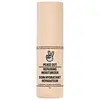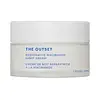What's inside
What's inside
 Key Ingredients
Key Ingredients

 Benefits
Benefits

 Concerns
Concerns

No concerns
 Ingredients Side-by-side
Ingredients Side-by-side

Water
Skin ConditioningNeopentyl Glycol Diheptanoate
EmollientGlycerin
HumectantPropanediol
SolventCoconut Alkanes
EmollientTriheptanoin
Skin ConditioningBrassica Glycerides
EmollientCetearyl Olivate
Coco-Caprylate/Caprate
EmollientHydrogenated Ethylhexyl Olivate
EmollientSorbitan Olivate
EmulsifyingBakuchiol
AntimicrobialNiacinamide
SmoothingPolymethylsilsesquioxane/Silica Crosspolymer
Squalane
EmollientCeramide EOP
Skin ConditioningCeramide NP
Skin ConditioningCeramide AP
Skin ConditioningUbiquinone
AntioxidantCannabis Sativa Seed Oil
EmollientPassiflora Edulis Seed Oil
EmollientMoringa Oleifera Seed Oil
EmollientRosa Canina Seed Oil
EmollientPavlova Lutheri Extract
Skin ConditioningSalix Alba Bark Extract
AstringentCholesterol
EmollientLauroyl Lysine
Skin ConditioningPhytosphingosine
Skin ConditioningSaccharomyces Ferment
Skin ConditioningCastor Oil/Ipdi Copolymer
Sodium Lauroyl Lactylate
EmulsifyingCaprylhydroxamic Acid
Dilinoleic Acid/Butanediol Copolymer
Trisodium Ethylenediamine Disuccinate
C12-15 Alkyl Benzoate
AntimicrobialCitric Acid
BufferingTocopheryl Acetate
AntioxidantCarbomer
Emulsion Stabilising1,2-Hexanediol
Skin ConditioningHydroxyethyl Acrylate/Sodium Acryloyldimethyl Taurate Copolymer
Emulsion StabilisingEthylhexylglycerin
Skin ConditioningPolysorbate 60
EmulsifyingSorbitan Isostearate
EmulsifyingPhenoxyethanol
PreservativeWater, Neopentyl Glycol Diheptanoate, Glycerin, Propanediol, Coconut Alkanes, Triheptanoin, Brassica Glycerides, Cetearyl Olivate, Coco-Caprylate/Caprate, Hydrogenated Ethylhexyl Olivate, Sorbitan Olivate, Bakuchiol, Niacinamide, Polymethylsilsesquioxane/Silica Crosspolymer, Squalane, Ceramide EOP, Ceramide NP, Ceramide AP, Ubiquinone, Cannabis Sativa Seed Oil, Passiflora Edulis Seed Oil, Moringa Oleifera Seed Oil, Rosa Canina Seed Oil, Pavlova Lutheri Extract, Salix Alba Bark Extract, Cholesterol, Lauroyl Lysine, Phytosphingosine, Saccharomyces Ferment, Castor Oil/Ipdi Copolymer, Sodium Lauroyl Lactylate, Caprylhydroxamic Acid, Dilinoleic Acid/Butanediol Copolymer, Trisodium Ethylenediamine Disuccinate, C12-15 Alkyl Benzoate, Citric Acid, Tocopheryl Acetate, Carbomer, 1,2-Hexanediol, Hydroxyethyl Acrylate/Sodium Acryloyldimethyl Taurate Copolymer, Ethylhexylglycerin, Polysorbate 60, Sorbitan Isostearate, Phenoxyethanol
Water
Skin ConditioningCaprylic/Capric Triglyceride
MaskingCetyl Palmitate
EmollientPropanediol
SolventHydrogenated Sunflower Seed Oil Polyglyceryl-3 Esters
EmulsifyingGlycerin
HumectantHelianthus Annuus Seed Oil
EmollientMyristyl Myristate
EmollientDicaprylyl Carbonate
EmollientHydrogenated Ethylhexyl Olivate
EmollientHydrogenated Sunflower Seed Oil Glyceryl Esters
EmulsifyingOenothera Biennis Oil
EmollientPentylene Glycol
Skin ConditioningVitis Vinifera Seed Oil
EmollientHydrogenated Vegetable Oil
EmollientPersea Gratissima Oil
Skin ConditioningNiacinamide
SmoothingCassia Angustifolia Seed Polysaccharide
Skin ConditioningBakuchiol
AntimicrobialChamomilla Recutita Flower Extract
MaskingCitrus Aurantium Dulcis Fruit Extract
MaskingCitrus Limon Fruit Extract
MaskingSaccharum Officinarum Extract
MoisturisingAcer Saccharum Extract
Skin ConditioningVaccinium Myrtillus Fruit/Leaf Extract
AstringentGlycyrrhiza Glabra Root Extract
BleachingGlycine Soja Oil
EmollientHydrogenated Olive Oil Unsaponifiables
EmollientHydrolyzed Jojoba Esters
Skin ConditioningJojoba Esters
EmollientSodium Hyaluronate
HumectantPhenoxyethanol
PreservativeCetearyl Alcohol
EmollientMicrocrystalline Cellulose
AbsorbentCapryloyl Glycerin/Sebacic Acid Copolymer
Skin ConditioningSodium Stearoyl Lactylate
EmulsifyingAcacia Senegal Gum
MaskingDiheptyl Succinate
EmollientXanthan Gum
EmulsifyingCellulose Gum
Emulsion StabilisingSaccharide Isomerate
HumectantPanthenol
Skin ConditioningCaprylyl Glycol
EmollientTocopherol
AntioxidantTocopheryl Acetate
AntioxidantDextran
Trifluoroacetyl Tripeptide-2
Skin ConditioningCitric Acid
BufferingSodium Citrate
BufferingSodium Phytate
Water, Caprylic/Capric Triglyceride, Cetyl Palmitate, Propanediol, Hydrogenated Sunflower Seed Oil Polyglyceryl-3 Esters, Glycerin, Helianthus Annuus Seed Oil, Myristyl Myristate, Dicaprylyl Carbonate, Hydrogenated Ethylhexyl Olivate, Hydrogenated Sunflower Seed Oil Glyceryl Esters, Oenothera Biennis Oil, Pentylene Glycol, Vitis Vinifera Seed Oil, Hydrogenated Vegetable Oil, Persea Gratissima Oil, Niacinamide, Cassia Angustifolia Seed Polysaccharide, Bakuchiol, Chamomilla Recutita Flower Extract, Citrus Aurantium Dulcis Fruit Extract, Citrus Limon Fruit Extract, Saccharum Officinarum Extract, Acer Saccharum Extract, Vaccinium Myrtillus Fruit/Leaf Extract, Glycyrrhiza Glabra Root Extract, Glycine Soja Oil, Hydrogenated Olive Oil Unsaponifiables, Hydrolyzed Jojoba Esters, Jojoba Esters, Sodium Hyaluronate, Phenoxyethanol, Cetearyl Alcohol, Microcrystalline Cellulose, Capryloyl Glycerin/Sebacic Acid Copolymer, Sodium Stearoyl Lactylate, Acacia Senegal Gum, Diheptyl Succinate, Xanthan Gum, Cellulose Gum, Saccharide Isomerate, Panthenol, Caprylyl Glycol, Tocopherol, Tocopheryl Acetate, Dextran, Trifluoroacetyl Tripeptide-2, Citric Acid, Sodium Citrate, Sodium Phytate
 Reviews
Reviews

Ingredients Explained
These ingredients are found in both products.
Ingredients higher up in an ingredient list are typically present in a larger amount.
Bakuchiol is a plant-derived antioxidant (it's vegan!). It is often called the replacement for retinol although it is not part of the same family.
It has similar effects as retinol: skin smoothing, reducing discoloration, and preventing wrinkles. It does not cause as much irritation as traditional retinoids.
Bakuchiol works by breaking down free radicals and stimulating collagen production in skin.
Combining bakuchiol with retinol will not have adverse side effects. Studies show using them will just boost the benefits. Bakuchiol is also found to help stabilize retinol.
While bakuchiol does not make the skin more sun sensitive, we recommend wearing SPF on a daily basis.
Read more about traditional retinol
Learn more about BakuchiolCitric Acid is an alpha hydroxy acid (AHA) naturally found in citrus fruits like oranges, lemons, and limes.
Like other AHAs, citric acid can exfoliate skin by breaking down the bonds that hold dead skin cells together. This helps reveal smoother and brighter skin underneath.
However, this exfoliating effect only happens at high concentrations (20%) which can be hard to find in cosmetic products.
Due to this, citric acid is usually included in small amounts as a pH adjuster. This helps keep products slightly more acidic and compatible with skin's natural pH.
In skincare formulas, citric acid can:
While it can provide some skin benefits, research shows lactic acid and glycolic acid are generally more effective and less irritating exfoliants.
Most citric acid used in skincare today is made by fermenting sugars (usually from molasses). This synthetic version is identical to the natural citrus form but easier to stabilize and use in formulations.
Read more about some other popular AHA's here:
Learn more about Citric AcidGlycerin is already naturally found in your skin. It helps moisturize and protect your skin.
A study from 2016 found glycerin to be more effective as a humectant than AHAs and hyaluronic acid.
As a humectant, it helps the skin stay hydrated by pulling moisture to your skin. The low molecular weight of glycerin allows it to pull moisture into the deeper layers of your skin.
Hydrated skin improves your skin barrier; Your skin barrier helps protect against irritants and bacteria.
Glycerin has also been found to have antimicrobial and antiviral properties. Due to these properties, glycerin is often used in wound and burn treatments.
In cosmetics, glycerin is usually derived from plants such as soybean or palm. However, it can also be sourced from animals, such as tallow or animal fat.
This ingredient is organic, colorless, odorless, and non-toxic.
Glycerin is the name for this ingredient in American English. British English uses Glycerol/Glycerine.
Learn more about GlycerinWe don't have a description for Hydrogenated Ethylhexyl Olivate yet.
Niacinamide is a multitasking form of vitamin B3 that strengthens the skin barrier, reduces pores and dark spots, regulates oil, and improves signs of aging.
And the best part? It's gentle and well-tolerated by most skin types, including sensitive and reactive skin.
You might have heard of "niacin flush", or the reddening of skin that causes itchiness. Niacinamide has not been found to cause this.
In very rare cases, some individuals may not be able to tolerate niacinamide at all or experience an allergic reaction to it.
If you are experiencing flaking, irritation, and dryness with this ingredient, be sure to double check all your products as this ingredient can be found in all categories of skincare.
When incorporating niacinamide into your routine, look out for concentration amounts. Typically, 5% niacinamide provides benefits such as fading dark spots. However, if you have sensitive skin, it is better to begin with a smaller concentration.
When you apply niacinamide to your skin, your body converts it into nicotinamide adenine dinucleotide (NAD). NAD is an essential coenzyme that is already found in your cells as "fuel" and powers countless biological processes.
In your skin, NAD helps repair cell damage, produce new healthy cells, support collagen production, strengthen the skin barrier, and fight environmental stressors (like UV and pollution).
Our natural NAD levels start to decline with age, leading to slower skin repair, visible aging, and a weaker skin barrier. By providing your skin niacinamide, you're recharging your skin's NAD levels. This leads to stronger, healthier, and younger looking skin.
Another name for vitamin B3 is nicotinamide. This vitamin is water-soluble and our bodies don't store it. We obtain Vitamin B3 from either food or skincare. Meat, fish, wheat, yeast, and leafy greens contain vitamin B3.
The type of niacinamide used in skincare is synthetically created.
Learn more about NiacinamidePhenoxyethanol is a preservative that has germicide, antimicrobial, and aromatic properties. Studies show that phenoxyethanol can prevent microbial growth. By itself, it has a scent that is similar to that of a rose.
It's often used in formulations along with Caprylyl Glycol to preserve the shelf life of products.
Propanediol is an all-star ingredient. It softens, hydrates, and smooths the skin.
It’s often used to:
Propanediol is not likely to cause sensitivity and considered safe to use. It is derived from corn or petroleum with a clear color and no scent.
Learn more about PropanediolTocopheryl Acetate is AKA Vitamin E. It is an antioxidant and protects your skin from free radicals. Free radicals damage the skin by breaking down collagen.
One study found using Tocopheryl Acetate with Vitamin C decreased the number of sunburned cells.
Tocopheryl Acetate is commonly found in both skincare and dietary supplements.
Learn more about Tocopheryl AcetateWater. It's the most common cosmetic ingredient of all. You'll usually see it at the top of ingredient lists, meaning that it makes up the largest part of the product.
So why is it so popular? Water most often acts as a solvent - this means that it helps dissolve other ingredients into the formulation.
You'll also recognize water as that liquid we all need to stay alive. If you see this, drink a glass of water. Stay hydrated!
Learn more about Water